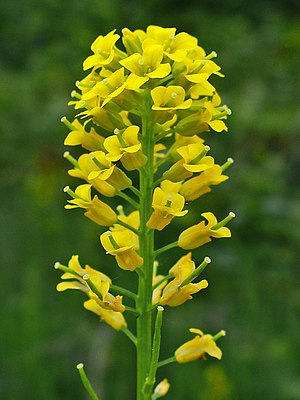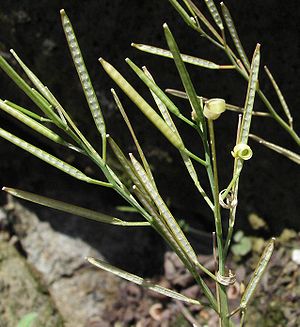Brassicaceae
This article needs additional citations for verification. (April 2015) (Learn how and when to remove this template message) |
| Brassicaceae | |
|---|---|

| |
| Winter cress, Barbarea vulgaris | |
| Scientific classification | |
| Kingdom: | |
| (unranked): | |
| (unranked): | |
| (unranked): | |
| Order: | |
| Family: | Brassicaceae |
| Genera | |
|
See text. | |
Brassicaceae or Cruciferae is a medium-sized and economically important family of flowering plants commonly known as the mustards, the crucifers, or the cabbage family.
The name Brassicaceae is derived from the included genus Brassica. The alternative older name, Cruciferae (English: /kruːˈsɪfəri/), meaning "cross-bearing", describes the four petals of mustard flowers, which resemble a cross. Cruciferae is one of eight plant family names without the suffix -aceae that are authorized alternative names (according to ICBN Art. 18.5 and 18.6 Vienna Code).
The family contains 372 genera and 4060 accepted species.[2] The largest genera are Draba (440 species), Erysimum (261 species), Lepidium (234 species), Cardamine (233 species), and Alyssum (207 species).
The family contains the cruciferous vegetables, including species such as Brassica oleracea (e.g., broccoli, cabbage, cauliflower, kale, collards), Brassica rapa (turnip, Chinese cabbage, etc.), Brassica napus (rapeseed, etc.), Raphanus sativus (common radish), Armoracia rusticana (horseradish), Matthiola (stock) and the model organism Arabidopsis thaliana (thale cress).
Pieris rapae and other butterflies of the family Pieridae are some of the best-known pests of Brassicaceae species planted as commercial crops.
Taxonomy
The family is included in the Brassicales according to the APG system. Older systems (e.g., Arthur Cronquist's) placed them into the Capparales, a now-defunct order that had a similar definition.
This family comprises about 375 genera and 2500 species all over the world; 94 species of 38 genera are found in Nepal. The plants are mostly herbs. A close relationship has long been acknowledged between the Brassicaceae and the caper family, Capparaceae, in part because members of both groups produce glucosinolate (mustard oil) compounds. The Capparaceae as traditionally circumscribed were paraphyletic with respect to Brassicaceae, with Cleome and several related genera being more closely related to the Brassicaceae than to other Capparaceae.[3] The APG II system, therefore, has merged the two families under the name Brassicaceae. Other classifications have continued to recognize the Capparaceae, but with a more restricted circumscription, either including Cleome and its relatives in the Brassicaceae or recognizing them in the segregate family Cleomaceae. The APG III system has recently adopted this last solution, but this may change as a consensus arises on this point. This article deals with Brassicaceae sensu stricto, i.e. treating the Cleomaceae and Capparaceae as segregated families.
| Brassicaceae s.l. |
| ||||||||||||
Description

The family consists mostly of herbaceous plants with annual, biennial, or perennial lifespans. However, around the Mediterranean, they include also a dozen woody shrubs 1-3 m tall, e.g. in northern Africa (Zilla spinosa and Ptilotrichum spinosum), in the Dalmatian islands (Dendralyssum and Cramboxylon), and chiefly in Canarias with some woody cruciferous genera: Dendrosinapis, Descurainia, Parolinia, Stanleya, etc..
The leaves are alternate (rarely opposite), sometimes organized in basal rosettes; in rare shrubby crucifers of Mediterranean their leaves are mostly in terminal rosettes, and may be coriaceous and evergreen. They are very often pinnately incised and do not have stipules.
The structure of the flowers is extremely uniform throughout the family. They have four free saccate sepals and four clawed free petals, staggered. They can be disymmetric or slightly zygomorphic, with a typical cross-like arrangement (hence the name Cruciferae). They have six stamens, four of which are longer (as long as the petals) and are arranged in a cross like the petals and the other two are shorter (tetradynamous flower). The pistil is made up of two fused carpels and the style is very short, with two lobes. The ovary is superior. The flowers form ebracteate racemose inflorescences, often apically corymb-like.[clarification needed]
Pollination occurs by entomogamy; nectar is produced at the base of the stamens and stored on the sepals.

The fruit is a peculiar kind of capsule named siliqua (plural siliquae). It opens by two valves, which are the modified carpels, leaving the seeds attached to a framework made up of the placenta and tissue from the junction between the valves (replum). Often, an indehiscent beak occurs at the top of the style and one or more seeds may be borne there. Where a siliqua is less than three times as long as it is broad, it is usually termed a silicula. The siliqua may break apart at constrictions occurring between the segments of the seeds, thus forming a sort of loment (e.g., Raphanus), it may eject the seeds explosively (e.g., Cardamine) or may be evolved in a sort of samara (e.g., Isatis). The fruit is often the most important diagnostic character for plants in this family. Most members share a suite of glucosinolate compounds that have a typical pungent odour usually associated with cole crops.
Uses

The importance of this family for food crops has led to its selective breeding throughout history. Some examples of cruciferous food plants are the cabbage, broccoli, cauliflower, turnip, rapeseed, mustard, radish, horseradish, cress, wasabi, and watercress.
Matthiola (stock), Cheiranthus, Lobularia, and Iberis (candytufts) are appreciated for their flowers. Lunaria (honesty) is cultivated for the decorative value of the translucent replum of the round silicula that remains on the dried stems after dehiscence.
Capsella bursa-pastoris, Lepidium, and many Cardamine species are common weeds.
Isatis tinctoria (woad) was used in the past to produce the colour indigo.
Arabidopsis thaliana is a very important model organism in the study of the flowering plants (Angiospermae).
Etymology and pronunciation
The name "Brassicaceae" (English: /ˌbræsɪˈkeɪsi,
Genera
- Aethionema
- Agallis
- Alliaria
- Alyssoides
- Alyssopsis
- Alyssum
- Ammosperma
- Anastatica
- Anchonium
- Andrzeiowskia
- Anelsonia
- Aphragmus
- Aplanodes
- Arabidella
- Arabidopsis
- Arabis
- Arcyosperma
- Armoracia
- Aschersoniodoxa
- Asperuginoides
- Asta
- Atelanthera
- Athysanus
- Aubrieta
- Aurinia
- Ballantinia
- Barbarea
- Beringia
- Berteroa
- Berteroella
- Biscutella
- Bivonaea
- Blennodia
- Boechera
- Boleum
- Boreava
- Bornmuellera
- Borodinia
- Botscantzevia
- Brachycarpaea
- Brassica
- Braya
- Brayopsis
- Brossardia
- Bunias
- Cakile
- Calepina
- Calymmatium
- Camelina
- Camelinopsis
- Capsella
- Cardamine
- Cardaminopsis
- Cardaria
- Carinavalva
- Carrichtera
- Catadysia
- Catenulina
- Caulanthus
- Caulostramina
- Ceratocnemum
- Ceriosperma
- Chalcanthus
- Chamira
- Chartoloma
- Cheesemania
- Cheiranthus
- Chlorocrambe
- Chorispora
- Christolea
- Chrysobraya
- Chrysochamela
- Cithareloma
- Clastopus
- Clausia
- Clypeola
- Cochlearia
- Coelonema
- Coincya
- Coluteocarpus
- Conringia
- Cordylocarpus
- Coronopus
- Crambe
- Crambella
- Cremolobus
- Crucihimalaya
- Cryptospora
- Cuphonotus
- Cusickiella
- Cycloptychis
- Cymatocarpus
- Cyphocardamum
- Dactylocardamum
- Degenia
- Delpinophytum
- Descurainia
- Diceratella
- Dichasianthus
- Dictyophragmus
- Didesmus
- Didymophysa
- Dielsiocharis
- Dilophia
- Dimorphocarpa
- Diplotaxis
- Dipoma
- Diptychocarpus
- Dithyrea
- Dolichirhynchus
- Dontostemon
- Douepea
- Draba
- Drabastrum
- Drabopsis
- Dryopetalon
- Eigia
- Elburzia
- Enarthrocarpus
- Englerocharis
- Eremobium
- Eremoblastus
- Eremodraba
- Eremophyton
- Ermania
- Ermaniopsis
- Erophila
- Eruca
- Erucaria
- Erucastrum
- Erysimum
- Euclidium
- Eudema
- Eutrema
- Euzomodendron
- Farsetia
- Fezia
- Fibigia
- Foleyola
- Fortuynia
- Galitzkya
- Geococcus
- Glaribraya
- Glastaria
- Glaucocarpum
- Goldbachia
- Gorodkovia
- Graellsia
- Grammosperma
- Guillenia
- Guiraoa
- Gynophorea
- Halimolobos
- Harmsiodoxa
- Hedinia
- Heldreichia
- Heliophila
- Hemicrambe
- Hemilophia
- Hesperis
- Heterodraba
- Hirschfeldia
- Hollermayera
- Hormathophylla
- Hornungia
- Hornwoodia
- Hugueninia
- Hymenolobus
- Ianhedgea
- Iberis
- Idahoa
- Iodanthus
- Ionopsidium
- Irenepharsus
- Isatis
- Ischnocarpus
- Iskandera
- Iti
- Ivania
- Jundzillia
- Kernera
- Kremeriella
- Lachnocapsa
- Lachnoloma
- Leavenworthia
- Lepidium
- Lepidostemon
- Leptaleum
- Lignariella
- Lithodraba
- Lobularia
- Lonchophora
- Loxostemon
- Lunaria
- Lyocarpus
- Lyrocarpa
- Macropodium
- Malcolmia
- Mancoa
- Maresia
- Mathewsia
- Matthiola
- Megacarpaea
- Megadenia
- Menkea
- Menonvillea
- Microlepidium
- Microsysymbrium
- Microstigma
- Morettia
- Moricandia
- Moriera
- Morisia
- Murbeckiella
- Muricaria
- Myagrum
- Nasturtiopsis
- Nasturtium
- Neomartinella
- Neotchihatchewia
- Neotorularia
- Nerisyrenia
- Neslia
- Nesocrambe
- Neuontobotrys
- Notoceras
- Notothlaspi
- Ochthodium
- Octoceras
- Olimarabidopsis
- Onuris
- Oreoloma
- Oreophyton
- Ornithocarpa
- Orychophragmus
- Otocarpus
- Oudneya
- Pachycladon
- Pachymitus
- Pachyphragma
- Pachypterygium
- Parlatoria
- Parodiodoxa
- Parolinia
- Parrya
- Parryodes
- Paysonia
- Pegaeophyton
- Peltaria
- Peltariopsis
- Pennellia
- Petiniotia
- Petrocallis
- Petrocallis
- Petroravenia
- Phlebolobium
- Phlegmatospermum
- Phoenicaulis
- Physaria
- Physocardamum
- Physoptychis
- Physorrhynchus
- Platycraspedum
- Polyctenium
- Polypsecadium
- Pringlea
- Prionotrichon
- Pritzelago
- Pseuderucaria
- Pseudoarabidopsis
- Pseudocamelina
- Pseudoclausia
- Pseudofortuynia
- Pseudovesicaria
- Psychine
- Pterygiosperma
- Pterygostemon
- Pugionium
- Pycnoplinthopsis
- Pycnoplinthus
- Pyramidium
- Quezeliantha
- Quidproquo
- Raffenaldia
- Raphanorhyncha
- Raphanus
- Rapistrum
- Reboudia
- Redowskia
- Rhammatophyllum
- Rhizobotrya
- Ricotia
- Robeschia
- Rollinsia
- Romanschulzia
- Roripella
- Rorippa
- Rytidocarpus
- Sameraria
- Sarcodraba
- Savignya
- Scambopus
- Schimpera
- Schivereckia
- Schizopetalon
- Schlechteria
- Schoenocrambe
- Schouwia
- Scoliaxon
- Selenia
- Sibara
- Sibaropsis
- Silicularia
- Sinapidendron
- Sinapis
- Sisymbrella
- Sisymbriopsis
- Sisymbrium
- Smelowskia
- Sobolewskia
- Solms-laubachia
- Sophiopsis
- Sphaerocardamum
- Spirorhynchus
- Spryginia
- Staintoniella
- Stanfordia
- Stanleya
- Stenopetalum
- Sterigmostemum
- Stevenia
- Straussiella
- Streptanthella
- Streptanthus
- Streptoloma
- Stroganowia
- Stubebdorffia
- Subularia
- Succowia
- Synstemon
- Synthlipsis
- Taphrospermum
- Tauscheria
- Teesdalia
- Teesdaliopsis
- Tetracme
- Thellungiella
- Thelypodiopsis
- Thelypodium
- Thlaspeocarpa
- Thlaspi
- Thysanocarpus
- Trachystoma
- Trichotolinum
- Trochiscus
- Tropidocarpum
- Turritis
- Vella
- Warea
- Weberbauera
- Werdermannia
- Winklera
- Xerodraba
- Yinshania
- Zerdana
- Zilla
See also
References
- ↑ Angiosperm Phylogeny Group (2009). "An update of the Angiosperm Phylogeny Group classification for the orders and families of flowering plants: APG III" (PDF). Botanical Journal of the Linnean Society. 161 (2): 105–121. doi:10.1111/j.1095-8339.2009.00996.x. Retrieved 2013-07-06.
- ↑ "Brassicaceae". The Plant List.
- ↑ Hall, J. C.; Sytsma, K. J.; Iltis, H. H. (2002). "Phylogeny of Capparaceae and Brassicaceae based on chloroplast sequence data". American Journal of Botany. 89 (11): 1826–1842. doi:10.3732/ajb.89.11.1826. PMID 21665611.
- ↑ Merriam-Webster, Merriam-Webster's Unabridged Dictionary, Merriam-Webster.
Further reading
- Carlquist, Sherwin (1971). "Wood anatomy of Macaronesian and other Brassicaceae" (PDF). Aliso. 7 (3): 365–84.
- Walter S. Judd; Christopher S. Campbell; Elizabeth A. Kellogg; Peter F. Stevens; Michael J. Donoghue, eds. (2008). Plant Systematics: A Phylogenetic Approach. Sinauer Associates. ISBN 978-0-87893-407-2.
- Stevens, P. F. (2001 onwards). Angiosperm Phylogeny Website. Version 7, May 2006 [and more or less continuously updated since]. [1]
- Strasburger, Noll, Schenck, Schimper: Lehrbuch der Botanik für Hochschulen. 4. Auflage, Gustav Fischer, Jena 1900, p. 459
External links
| Wikimedia Commons has media related to Brassicaceae. |
| Wikispecies has information related to Brassicaceae |
- Brassicaceae in L. Watson and M.J. Dallwitz (1992 onwards). The families of flowering plants: descriptions, illustrations, identification, information retrieval. https://web.archive.org/web/20070103200438/http://delta-intkey.com:80/
- Brassicaceae at www.botany.hawaii.edu
- Family Brassicaceae Flowers in Israel
Lua error in Module:Taxonbar at line 144: attempt to index field 'wikibase' (a nil value).
- Pages with script errors
- Articles needing additional references from April 2015
- All articles needing additional references
- Wikipedia articles needing clarification from July 2016
- Pages using div col with unknown parameters
- Commons category link is defined as the pagename
- Commons category link is on Wikidata using P373
- Brassicaceae
- Brassicales families
